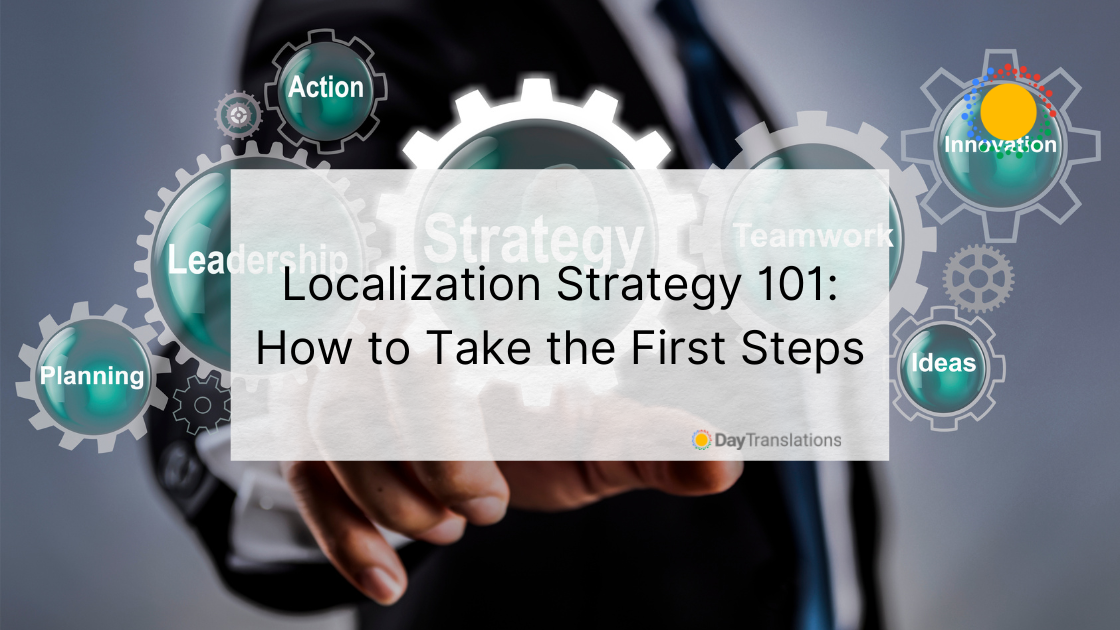This article is part of our Localization Guide – check it out to access all the resources we have designed to help you expand your brand abroad!
____________________________________________________________
Localization is a must-have when it comes to going global with your business. A huge part of increasing revenue, market share, and building a strong customer base is centered around having a solid business localization strategy.
This article will deepen beyond the concept of localization itself, organizing the most important steps to be considered to help you launch a localization process of your own.
Where do I start?
As we know by now, localization is the way a company adapts its service to a particular culture and its language. Localization strategy is the planning of entering a new market, whether it’s through websites, social media, blog-writing or any other channel. The point is to connect with the local customer and to accomplish that, there´s an adaptation process applied to your business’s content: everything from a simple image to a product has to be evaluated from an international market’s perspective.
This evaluation will require an investment of time in your part, but it will also help you gain a better position to efficiently meet your customer’s needs. When facing a cross-cultural market, it´s fundamental to meet local requirements and cultural preferences. After the detailed information included in our Localization Guide, it’s advisable to first recognize the benefits that would be obtained after implementing an efficient localization strategy:
-
Entering New Markets more rapidly
Overcoming cultural barriers will get you a step closer to an invaluable asset: a new client from a new market will spread the word about your product, which is the best kind of marketing there is. This type of promotion is free, and it will kick-start your journey towards becoming the top-of-mind of your new clientele But this cannot happen if your product is not localized, or worse, if it’s poorly localized and battling against local traditions and consumer habits.
Furthermore, rapid deployment of products or services gives you a competitive advantage –the faster you localize your business, the faster it grows. When you find a localization company you trust, you’ll be making sure you won’t be wasting time going back on product strategies or rebranding, and you’ll be able to use the insights found in their market research phase for your other advertising strategies within the target region.
-
Increasing customer satisfaction (hence, potential customer base)
One significant pro of localization is that it helps support making user experience appealing, not only by merely translating content but also by understanding the local market conditions in a better way so as to develop your product in an innovative and competitive way.
Now, once the perks of localization are clear, and the choice is made to carefully design a localization strategy, here are the essential steps that we encourage you to follow:
The First Step of a Localization Strategy
Are we all setup? Make sure that your product or service is localization-ready.
The bases that later on will guarantee the success of the process is the planning. So, begin by planning and researching. Learn about your target market, and get familiar with the most distinguished features of where you are heading.
Remember, the main goal in this part of the process is to accomplish a clever message adaptation and, to get there, you need to get to know who you´re talking to.
Let’s go over some more practical tips:
- Check your website traffic visitors: where is that traffic based? What is their culture like? What is the most prominent religion? What are some common traditions there?
- How many different areas do you want to cover? The cost of localization will increase depending on how many languages you want to localize your business into.
- Analyze the needs and suggestions of your users/ costumers.
- Legislation, what is your framework there? Do you need counseling? Are all components of your product legal in your target region? How are copyright laws?
- Go to available statistics: for example, researchers show that 87% of people who can’t understand English, will not buy from English-only websites.
- Internet speeds. Make sure to verify your business’s website speed and the Internet access of your targeted region)
So, again. Plan and research. Run a market research using the questions suggested above and implement other marketing visual graphs, such as Porter’s five Forces Framework.
Building Your L10N Team
Build up a good team and hire locals. You will need people with the right skillset and talent to collaborate in the modeling of the localization plan. The most likely scenario is one where most of your team members work remotely so as to cover the demand of your product in different regions of the world. And this is the part where locals come in.
You´ll need native translators to help you capture the tone and voice behind your messages directed to every audience. This is why it is crucial to count with experts in the field that could also lead the reconstruction of the original content in a way that the specific characteristics of the product or service don´t get lost during this process.
Look for local marketing advisors and include them in this team as well. Maybe even legal consultants, especially for matters of anti-competition laws and local regulations. Restrictions will vary according to the country you’re in. Find a reliable agency with a background on localization services capable of advising on how to approach a new market.
‘Making an Impact’ with Your Localization Strategy
Leave your mark. It might sound like a millenial cliché, but it does ring true. It’s vital to make an impact that reflects your company´s genuine and unique identity.
Before any actual contact with an unknown market, it’s necessary to count with a precise idea of what makes you different from others: present a clear identity that communicates what your brand is about and establish the main benefits you offer, separating your business from your competitors.
To take this step, it would be smart to determine which are your value-added services, your extra, and then analyze whether they are locally relevant.
Tools & L10N Prioritization
This last but not least important step is centered around two key points: tools and prioritization.
When it comes to tools, international SEO is the one that will make the difference for your brand’s digital presence.Search Engine Optimization is the process of optimizing your website traffic from the search engine results page. Localizing your content will bring your website upper in a given location´s search results.
When it comes to prioritization, there are some decisions that need to be made. It would be wise to prioritize the parts of your company that you would need to localize first. Do not invest time localizing a website and its marketing collateral if the product itself is not ready for an international audience. Things like user manuals and product interfaces always come first. If you’re unsure if your product will be demanded by your new audience to begin with, consider developing a simple landing page to generate leads, but once you’ve gathered enough insights, localize your product straight away before promoting it.
As a general rule, it’s smart to minimize the pieces of content that have to be culturally specific (and, therefore, exclusive). Instead, when generating articles, ads, webpages and brochures, try to target the broadest possible audience, so that all of these materials are easy to adapt when it’s needed.














Sorry, the comment form is closed at this time.